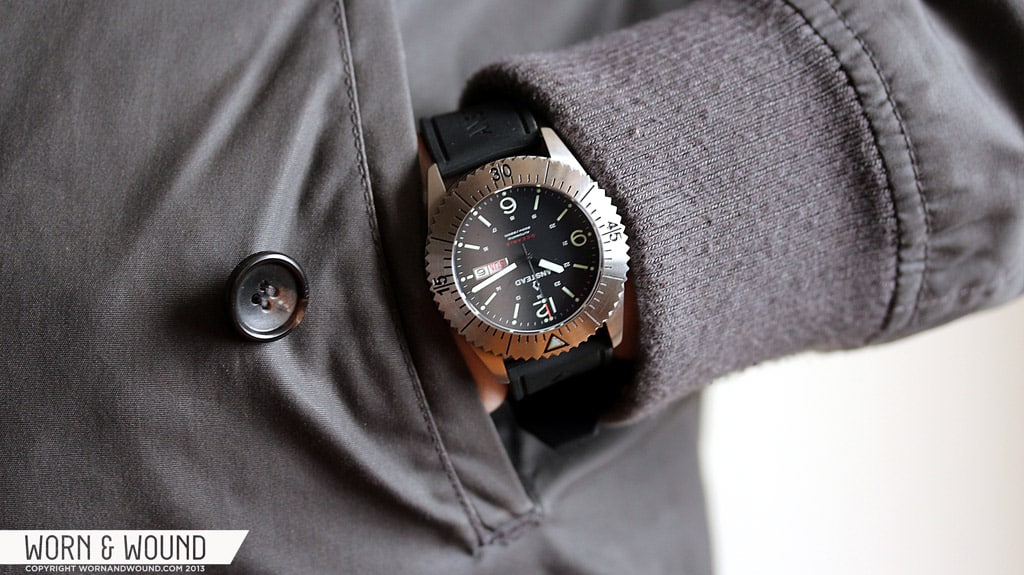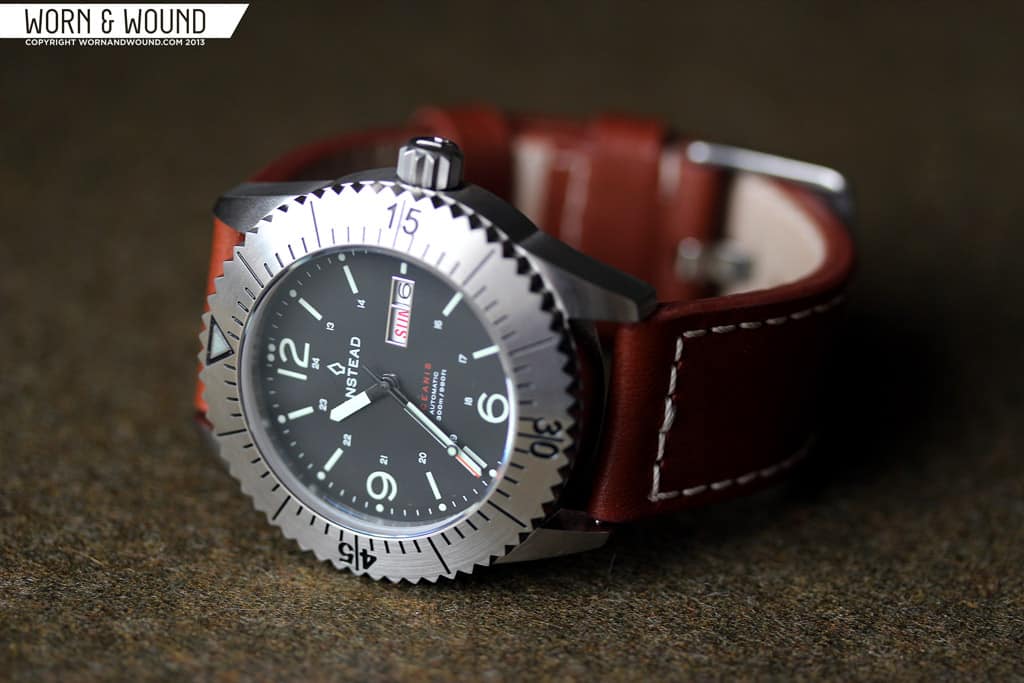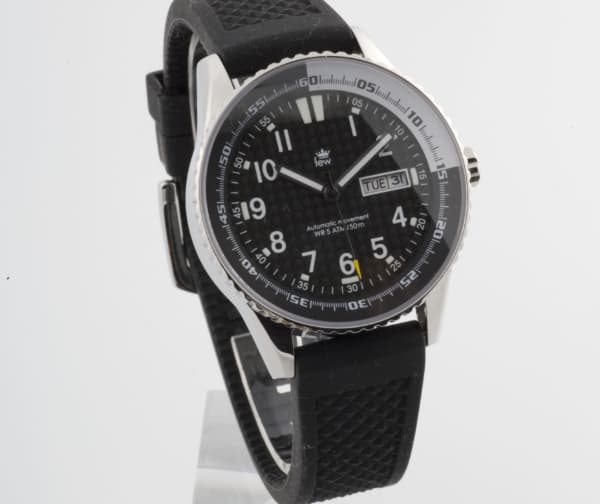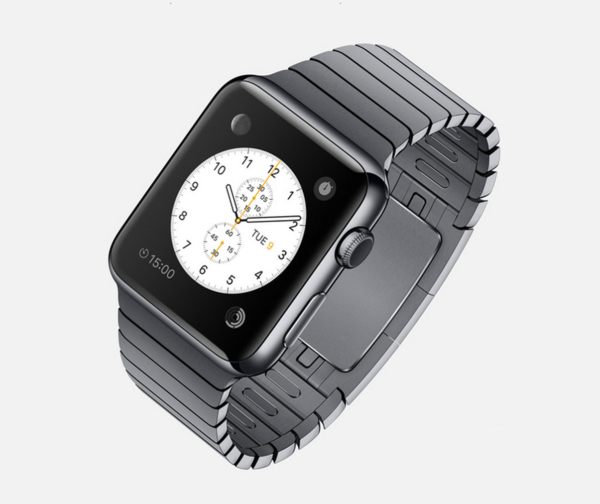A few weeks ago, we got the chance to chat with Tom Anstead, owner and designer of Anstead Watches. Anstead is a retired officer of the United States Navy. His naval career, as well as the watches available to him during his time in service, very much informed the design of the Anstead Oceanis.
Anstead’s first generation Oceanis debuted a couple of years ago, a product of one of the early Kickstarter watch campaigns. The second generation debuted in September. We wanted to get his thoughts on a second generation timepiece, his plans for the future of Anstead Watches, and his thoughts on the potential of the watch industry in the United States.
Ed Estlow for Worn and Wound:
With easy global sourcing and availability of watch parts, there are dozens, maybe hundreds, of boutique brands starting up. I’m curious – what was your motivation or overall goal for starting another one?
Tom Anstead:
Well, from my prospective, I didn’t necessarily see the hundreds of boutique brands. I knew of some out there, but mine was really more of a love of watches and the desire to start a business and I looked into the possibility of starting my own brand.
I also love to design things on the side. I’ve always enjoyed art, enjoyed design, and thought I could design my own look. Anyway, I looked into the possibility of doing it and discovered I could figure out how to source the right parts from the right places, and I saw that it was possible.
And also, I will say I really admired so many of these high-end Swiss watches and didn’t want to spend $5,000 or more for one of them. But I wasn’t seeing the kind of watch that I wanted to own at a lower price point, and I thought, “Well, I’d like to design my own.”
W&W: You were struggling to find a watch that you liked at, say, under $1000. Did you just not like the look or the feel of existing watches at those prices?
TA: Yeah, I think that was it. I mean I just couldn’t find a single watch that jumped out at me so much for the right price, that I said that’s really the one I want to own. Nothing had all the right features to me. You know, the right size, the right movement, the right qualities and functionality.
But, of course, there’s thousands of watches out there. There’s so many looks, and you think with that kind of selection, anybody can be happy. I would look at them, and I loved and admired them, but it’s like, “Oh yeah, that one costs $5,000. It’s wonderful.” But, you know, if I didn’t have that kind of money, what did I want to get?
I wasn’t seeing anything under $1,000 that jumped out at me, that I wanted to own. And of course, it wasn’t just “I can’t find a watch I like. I’ll make my own” because one could say the same thing about a shirt or a pair of jeans or something. It was my love for watches and my wanting to create something. I saw that opportunity and I said, “Yeah, I wonder if I can do this or if I can make this.”
W&W: The reception for the Oceanis has been pretty good, correct?
TA: I’ve gotten a lot of positive feedback, and the Kickstarter campaign – the original one – was very successful. People generally have really liked it. I feel in designing for myself, I was able to tap into a look and feel and the quality that I think a lot of other people were looking for as well. At the right price, of course.
W&W: The current watch is a evolutionary second generation piece. Did you take on the redesign as the result of feedback on the first design, or were you simply looking to upgrade or evolve the design independently of feedback?
TA: It was a little of both. You know, in the first generation I definitely had a vision of what I wanted. When I got that done, I realized that some of the things were not really what I wanted them ultimately to be – including the bezel. I mean, I know the bezel was too stiff. I was unhappy with that. That wasn’t something that I controlled as much as I thought I could. So I did change where I sourced it from and the quality is even higher now.
There were some design inputs I got from people along the way, and people are very passionate about it, which is great. People are passionate, and I really enjoyed listening to the people who were so passionate about it, and I felt like nobody gave me negative input. They were always telling me things they wanted to see changed because they were excited about the watch; they were excited about the brand.
They weren’t saying, “I don’t like this, and therefore, I’m not going to buy it.” They were buying it and they loved it and they were like, “Why doesn’t it have this instead of that and why don’t you change this.” And so I felt like this was an evolution, a positive evolution of the first generation.
I think people like yourself who can have both of them in their hands side-by-side will quickly recognize that this is a better watch. And I’m excited about that. I’m excited about putting out a better, higher quality product. I know it’s a higher price, but I know it’s worth that price.
I really hope to not change the design at this point. Going forward, this is going to be the watch. We’re not going to keep seeing changes.
W&W: You talk about the higher quality with the current watch. Is that really the big driver behind the increase in price from the Generation 1 to the Gen 2.
TA: It is. This is a much higher priced watch for us. The costs are in it. You can see and feel the quality. There’s little variations like a double dome crystal. The engraving is much better.
W&W: I love that domed crystal, by the way.
TA: Oh, thanks. Yeah, I like it too. I think visually it makes the watch stand out a lot more. So there’s higher quality components in it, and you can just tell by feeling it that it’s a better quality watch.
There’s also the idea of going to retail with it eventually as well. I know most buyers may not fully appreciate it, but when you sell to retailers, you pretty much have to sell to them at an industry-standard wholesale discount. And for me to be able to do that, and still make any money, I had to essentially put a retail price on it, so I can be able to wholesale it to retailers.
Now it’s not at any retail locations yet, but I have to plan for that. I wouldn’t want to do a several hundred dollar price increase down the road and give people sticker shock. But I think everybody who sees and feels the watch will feel it and go “Yeah, that’s a $650 watch.” In fact, that’s a better quality watch than watches that are selling for a lot more.
W&W: Are you considering other designs that will create a more full line for Anstead Watches?
TA: I certainly am, and that’s my goal. I have seven other watches on the design board ready to go, and I already have the whole thing envisioned.
They’re still going to be in this line of military style watches with a vintage feel. I wouldn’t call the Oceanis a vintage watch. It’s not trying to copy any kind of old World War II watch or anything, but I think it has a bit of a vintage feel. I like those classic watches. I like a classic look.
Now what slows any company down is money, and so if I had more investment, I’d be able to make a more complete line quickly. If you know of anyone…
W&W: You’re looking at retail options?
TA: Yeah, first and foremost, I’d like to get a couple more watches out in the next year, and it all depends on how sales go with this one. You know, the faster I can sell, the more I can expand. Like I said, I already have about seven watches on the drawing board, and you know, I’d like to have a plan for eight watches.
I have a plan specifically for what I call the naval combat series so, you know, specialty watches that kind of take inspiration from aviation and special warfare and submarine warfare.
And then, of course, expand each option within those. Multiple straps, multiple colored dials, that sort of thing. You’d end up having a hundred different options. So that’s really the easiest way to expand a line.
I need to have a few more watches before I feel like I can go to retail successfully. You know, you need to show them a line and not just a watch, so that would be a big dream. I think I can get there.
I’ve toyed with the idea of making a quartz line just so I can have lower-priced options for more people to buy and enjoy the brand. But I really think I should stay with automatic movements because I want this to be a higher-end brand. You know, I don’t want to compete in that market. I don’t want to sell cheap, because as soon as that $100 watch exists, people don’t want to buy the $800 watch or the $2,000 watch. It’s like Ferrari coming out with a $30,000 model. It just doesn’t work.
I’m trying to stay in there at a few thousand units per year, keep it exclusive, but, of course, build the brand up enough that people know it and want to wear it. Right now it’s tough. You know, I’m really selling to the collectors. The people who are into watches and know watches and want this to be part of their collection. I think that’s a lot of the people who are buying.
But it takes a long time to get that brand recognition, until people recognize the brand, and say, “Oh, that’s something I really want. I want to wear that watch every day.”
W&W: What do you think of the current trend and craze in bronze watches?
TA: It’s a little bit of surprise to me. They’re not for me, but like in anything that’s artistic interpretation, all you can you kind of do is say, “Hey, that’s not for me” and move on. For somebody else, they love them and that’s fine. I don’t see myself ever doing a bronze watch. It’s probably something that in 10 years you’re not going to see bronze watches out anymore. But it certainly is interesting.
W&W: Are you strictly sourcing parts and then assembling stateside or are you specifying and sourcing the whole watch overseas?
TA: Well, I’m specifying it from the sources, and, you know, it’s made in China. It’s not a surprise based on the price point. Anybody who knows watches would know that already.
And, you know, the reality of it is, is that’s where the industry is and when people talk about making a watch, you know, you’ve got to think, “What does that involve, making them?” Because being a watch maker, it’s a lot like an automotive maker. They may assemble the car and they might make the engine, but they probably are souring parts – they are, in fact – from all over the world.
You know, I’ve seen these stats on American cars. A large percentage of the pieces are made overseas and then they’re all brought into the US and put together.
So that’s just the reality of modern global manufacturing. Even in a Swiss watch, a lot of the parts are made in China, and people don’t know that.
W&W: That brings up an interesting point. I try to ask everybody I talk to, who’s doing anything with making watches here in the United States, what about the Made in America approach to watches?
TA: It can be done. You know, that’s kind of my dream. I would love to bring more manufacturing to the US. The key to manufacturing in the US is high-end stuff, right? We can do computers well, we can do software, we do pharmaceuticals, medical devices, we build airplanes and cars. That’s what the US does well – high-end things.
We can’t make cheap plastic stuff because we can’t get the labor cheap enough. So we can do watches. There’s only a handful of countries in the world that can make really high-end things – and I’m talking like medical devices. And that’s the US and Japan and Switzerland. Now, Germany can do a little bit and Israel can do a little bit, but those are the main countries that can do it.
And just as Switzerland can make watches, we can make watches too, we just don’t because the industry isn’t here. And the industry has to grow up organically through capitalism. The government’s just not going to make it happen.
So we have the machines, we have the machinists, we have the machine shops. We could make it happen, so I would like to do that. I would love to be creating as much as possible here, and I know the US can make movements as well if somebody puts enough money into it.
But you know, I’ve got to get my boutique watch company up to a little bigger watch company before I can do that kind of stuff, but boy would I love to do it. It’s tough for one guy to build one watch at time. Doing it that way is definitely a boutique operation.
So to make watches at a little more of an industrial level, where you’re pumping out several thousand watches per year, that takes a machine shop with some people working in there. Anyway, that’s a long-term goal.
W&W: It’s interesting for me to hear you say that. There’s Cameron Weiss in Los Angeles who is a big proponent of bringing the vertical watch industry back into the US. I know Leo Padron in Minneapolis would like to do it. And then you’ve got Michael Kobold in Pittsburg, of course, and Keaton Myrick is making all his own movements and everything out in Oregon. And RGM, obviously, also in Pennsylvania. So there are little pockets of that attitude. I think you guys all ought to get together in some central location and talk about jumpstarting the American watch industry. Does that make any kind of sense?
TA: I think it makes huge sense, and I think it probably takes a group like that with some real financial backing to start. I mean, there’s no reason we couldn’t start a watch movement company and be able to sell movements to each other’s companies, as the American watch business, but be able to sell them to other boutique watchmakers as well. You know, just have a movement that people can buy.
I think if we were all living in Pennsylvania, it would make it easier. But here we are spread around a very big country. And then you get the competitiveness of people. “Well, I want my watch company to succeed,” and you don’t get that collaborative effort. But it does make sense.
And there’s probably something to be said for making an American watch consortium, a place where everybody can get together and talk. Call it the United Nations of Watchmaking, like a governor’s conference kind of thing where everybody can just have a place. We can talk and share ideas and stories and all make better watches. It would probably help.
W&W: I’ve talked to Michael Kobold, Leo Padron, and Cameron Weiss about this. I haven’t yet had a chance to talk to Roland Murphy or Keaton Myrick.
TA: Like a lot of these kinds of things, it takes the most powerful person of the group to bring a group together. Roland Murphy is probably the one. If he sent out the word, everybody would join in. You know, because he’s making the highest-end watches in America – really, really high-end stuff. He’s one, that if he sent out the word, it would probably bring everybody together. If I sent out the word, maybe nobody would respond. Or they’d say, “Well, maybe someday.”
W&W: Tom, I’ve really appreciated and enjoyed chatting with you, learning more about Anstead Watches, and hearing your insights. Thanks a bunch.
TA: Ok, thanks, Ed. This has been a great conversation. I think we’ve covered a lot of ground.









 Featured Videos
Featured Videos













